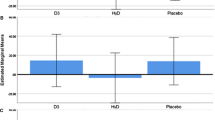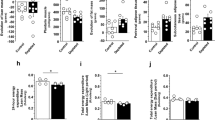Abstract
Vitamin D receptor (VDR) expression and action in non-human skeletal muscle have recently been reported in several studies, yet data on the activity and expression of VDR in human muscle cells are scarce. We conducted a series of studies to examine the (1) effect of 1,25-dihydroxyvitamin D3 (1,25(OH)2D3) on VDR gene expression in human primary myoblasts, (2) effect of 16-week supplementation with vitamin D3 on intramuscular VDR gene expression in older women, and (3) association between serum 25-hydroxyvitamin D (25OHD) and intramuscular VDR protein concentration in older adults. Human primary myoblasts were treated with increasing concentrations of 1,25(OH)2D3 for 18 h. A dose-dependent treatment effect was noted with 1 nmol/L of 1,25OH2D3 increasing intramuscular VDR mRNA expression (mean fold change ± SD 1.36 ± 0.33; P = 0.05). Muscle biopsies were obtained at baseline and 16 weeks after vitamin D3 supplementation (4,000 IU/day) in older adults. Intramuscular VDR mRNA was significantly different from placebo after 16 weeks of vitamin D3 (1.2 ± 0.99; −3.2 ± 1.7, respectively; P = 0.04). Serum 25OHD and intramuscular VDR protein expression were examined by immunoblot. 25OHD was associated with intramuscular VDR protein concentration (R = 0.67; P = 0.0028). In summary, our study found VDR gene expression increases following treatment with 1,25OH2D3 in human myoblasts. 25OHD is associated with VDR protein and 16 weeks of supplementation with vitamin D3 resulted in a persistent increase in VDR gene expression of vitamin D3 in muscle tissue biopsies. These findings suggest treatment with vitamin D compounds results in sustained increases in VDR in human skeletal muscle.






Similar content being viewed by others
References
Annweiler C, Schott AM, Montero-Odasso M, Berrut G, Fantino B, Herrmann FR, Beauchet O (2010) Cross-sectional association between serum vitamin D concentration and walking speed measured at usual and fast pace among older women: the EPIDOS study. J Bone Miner Res 25:1858–1866
Bischoff-Ferrari HA, Dietrich T, Orav EJ, Hu FB, Zhang Y, Karlson EW, Dawson-Hughes B (2004) Higher 25-hydroxyvitamin D concentrations are associated with better lower-extremity function in both active and inactive persons aged > or = 60 y. Am J Clin Nutr 80:752–758
Wicherts IS, van Schoor NM, Boeke AJ, Visser M, Deeg DJ, Smit J, Knol DL, Lips P (2007) Vitamin D status predicts physical performance and its decline in older persons. J Clin Endocrinol Metab 92:2058–2065
Schubert L, DeLuca HF (2010) Hypophosphatemia is responsible for skeletal muscle weakness of vitamin D deficiency. Arch Biochem Biophys 500:157–161
Simpson RU, Thomas GA, Arnold AJ (1985) Identification of 1,25-dihydroxyvitamin D3 receptors and activities in muscle. J Biol Chem 260:8882–8891
Costa EM, Blau HM, Feldman D (1986) 1,25-Dihydroxyvitamin D3 receptors and hormonal responses in cloned human skeletal muscle cells. Endocrinology 119:2214–2220
Bischoff HA, Borchers M, Gudat F, Duermueller U, Theiler R, Stahelin HB, Dick W (2001) In situ detection of 1,25-dihydroxyvitamin D3 receptor in human skeletal muscle tissue. Histochem J 33:19–24
Ceglia L, da Silva Morais M, Park LK, Morris E, Harris SS, Bischoff-Ferrari HA, Fielding RA, Dawson-Hughes B (2010) Multi-step immunofluorescent analysis of vitamin D receptor loci and myosin heavy chain isoforms in human skeletal muscle. J Mol Histol 41:137–142
Srikuea R, Zhang X, Park-Sarge OK, Esser KA (2012) VDR and CYP27B1 are expressed in C2C12 cells and regenerating skeletal muscle: potential role in suppression of myoblast proliferation. Am J Physiol Cell Physiol 303:C396–C405
Girgis CM, Mokbel N, Cha KM, Houweling PJ, Abboud M, Fraser DR, Mason RS, Clifton-Bligh RJ, Gunton JE (2014) The vitamin D receptor (VDR) is expressed in skeletal muscle of male mice and modulates 25-hydroxyvitamin D (25OHD) uptake in myofibers. Endocrinology 155:3227–3237
Wang Y, DeLuca HF (2011) Is the vitamin d receptor found in muscle? Endocrinology 152:354–363
Bischoff-Ferrari HA, Borchers M, Gudat F, Durmuller U, Stahelin HB, Dick W (2004) Vitamin D receptor expression in human muscle tissue decreases with age. J Bone Miner Res 19:265–269
Girgis CM, Clifton-Bligh RJ, Mokbel N, Cheng K, Gunton JE (2013) Vitamin D Signaling regulates proliferation, differentiation and myotube size in C2C12 skeletal muscle cells. Endocrinology 155:347–357
Guralnik JM, Simonsick EM, Ferrucci L, Glynn RJ, Berkman LF, Blazer DG, Scherr PA, Wallace RB (1994) A short physical performance battery assessing lower extremity function: association with self-reported disability and prediction of mortality and nursing home admission. J Gerontol 49:M85–M94
Ceglia L, Niramitmahapanya S, Morais MD, Rivas DA, Harris SS, Bischoff-Ferrari H, Fielding RA, Dawson-Hughes B (2013) A randomized study on the effect of vitamin D3 supplementation on skeletal muscle morphology and vitamin D receptor concentration in older women. J Clin Endocrinol Metab 98:E1927–E1935
Chale A, Cloutier GJ, Hau C, Phillips EM, Dallal GE, Fielding RA (2013) Efficacy of whey protein supplementation on resistance exercise-induced changes in lean mass, muscle strength, and physical function in mobility-limited older adults. The journals of gerontology. Biol Sci Med Sci A 68:682–690
Ceglia L, Rivas DA, Pojednic RM, Price LL, Harris SS, Smith D, Fielding RA, Dawson-Hughes B (2013) Effects of alkali supplementation and vitamin D insufficiency on rat skeletal muscle. Endocrine 44:454–464
Buitrago C, Pardo VG, Boland R (2013) Role of VDR in 1alpha,25-dihydroxyvitamin D-dependent non-genomic activation of MAPKs, Src and Akt in skeletal muscle cells. J Steroid Biochem Mol Biol 136:125–130
Boland RL (2011) VDR activation of intracellular signaling pathways in skeletal muscle. Mol Cell Endocrinol 347:11–16
Buitrago C, Boland R (2010) Caveolae and caveolin-1 are implicated in 1alpha,25(OH)2-vitamin D3-dependent modulation of Src, MAPK cascades and VDR localization in skeletal muscle cells. J Steroid Biochem Mol Biol 121:169–175
Capiati D, Benassati S, Boland RL (2002) 1,25(OH)2-vitamin D3 induces translocation of the vitamin D receptor (VDR) to the plasma membrane in skeletal muscle cells. J Cell Biochem 86:128–135
Acknowledgments
USDA Agricultural Research Service, under Agreement Nos. 58-1950-7-707 (to BDH and LC) and 58-1950-0-014 (to RAF); The Dairy Research Institute (R.A.F.), Boston Claude D. Pepper Older Americans Independence Center (1P30AG031679 to R.A.F.), the Boston Nutrition/Obesity Research Center (DK046200 to R.A.F.), and an NHLBI pre-doctoral training grant (T32HL69772 to RMP). Any opinions, findings, conclusion, or recommendation expressed in this publication are those of the author(s) and do not necessarily reflect the views of the U.S. Department of Agriculture.
Conflict of Interest
Rachele Pojednic, Lisa Ceglia, Karl Olsson, Thomas Gustafsson, Alice Lichtenstein, Bess Dawson-Hughes, and Roger Fielding declare that they have no conflict of interest.
Human and Animal Rights and Informed Consent
All procedures followed were in accordance with the ethical standards of the responsible committee on human experimentation (institutional and national) and with the Helsinki Declaration of 1975, as revised in 2000 (5).
Author information
Authors and Affiliations
Corresponding author
Rights and permissions
About this article
Cite this article
Pojednic, R.M., Ceglia, L., Olsson, K. et al. Effects of 1,25-Dihydroxyvitamin D3 and Vitamin D3 on the Expression of the Vitamin D Receptor in Human Skeletal Muscle Cells. Calcif Tissue Int 96, 256–263 (2015). https://doi.org/10.1007/s00223-014-9932-x
Received:
Accepted:
Published:
Issue Date:
DOI: https://doi.org/10.1007/s00223-014-9932-x




